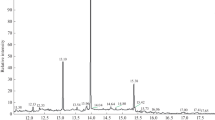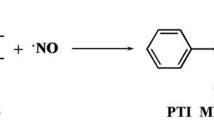Abstract
Chromatography-mass spectrometry of molecular metabolites in the expired air of resting healthy humans has been used to identify oxyketones, mainly 1-hydroxy-2-propanone (acetol), aldehydes (decenal, benzaldehyde), acetophenone, phenol, and fatty acids. During physical exercise (oxidative stress), the levels of ketones (heptanone-2 and heptanone-3), phenol, aldehydes identified (decenal and octadecenal), and acetol in the expired air decreased significantly, apparently, due to the prevalence of an alternative methylglycoxal metabolism of carbohydrates. It has been shown that the dynamics of saturated hydrocarbons in the expired air can be a source of information about the responses of the body to oxidative stress; while the concentration of acetone can be used as an indicator of fitness, the adequacy of physical loading, and an indicator of the development of hypoxic states.
Similar content being viewed by others
References
Baraboi, V.A., Bioantioksidanty (Bio-Antioxidants), Kiev, 2006.
GOST (State Standard) R ISO 16000, part 6: Indoor air. Analysis of Content of Volatile Organic Compounds in Indoor Air and Testing Chambers by Means of Active Sampling on Tenax TA Sorbent Followed by Thermal Desorption, Gas Chromatography Analysis, and the Use of MSD/PID, 2008.
Kolesova, O.E., Markin, A.A., and Fedorova, T.N., Lipid Peroxidation and Methods of Determination of Lipid Peroxidation Products in Biological Systems, Lab. Delo, 1984, no. 9, p. 540.
White, A. and Handler, P., Principles of Biochemistry, Tata McGraw Hill, 2004.
Amann, A. and Smith, D., Breath Analysis for Clinical Diagnosis and Therapeutic Monitoring, World Sci., 2005.
Brindle, J.T., Antti, H., Holmes, E., et al., Rapid and Non-Invasive Diagnosis of the Presence and Severity of Coronary Heart Disease Using 1H NMR-Based Metabolomics, Nature Med., 2002, vol. 8, no. 12, p. 1439.
Cao, W., and Duan, Y., Breath Analysis: Potential for Clinical Diagnosis and Exposure Assessment, Clin. Chemistry, 2006, vol. 52, no. 5. p. 800.
Moretti, M., Rhillips, M., Abouzeid, A., Cataneo, R.N., and Greenberg, J., Increased Breath Markers of Oxidative Stress in Normal Pregnancy and in Preeclampsiaio, Am. J. Obst. Gynecol., 2004.
Nicholson, J.K., Lindon, J.C., and Holmes, E., Metabolomics: Understanding the Metabolic Responses of Living Systems to Pathophysiological Stimuli via Multivariate Statistical Analysis of Biological NMR Spectroscopic Data, Xenobiotica, 1999, vol. 11, p. 1182.
O’Hara, M.E., Clutton-Brock, T.H, Green, S., and Mayhew, C.E., Endogenous Volatile Organic Compounds in Breath and Blood of Healthy Volunteers: Examining Breath Analysis as a Surrogate for Blood Measurements, J. Breath Res., 2009, vol. 3, p. 27005.
Author information
Authors and Affiliations
Additional information
Original Russian Text © R.G. Mardanov, O.I. Orlov, A.A. Markin, D.S. Tsar’kov, L.N. Mukhamedieva, 2010, published in Aviakosmicheskaya i Ekologicheskaya Meditsina, 2010, Vol. 44, No. 6, pp. 44–48.
Rights and permissions
About this article
Cite this article
Mardanov, R.G., Orlov, O.I., Markin, A.A. et al. Molecular markers of oxidative stress in the expired air of healthy humans. Hum Physiol 38, 794–797 (2012). https://doi.org/10.1134/S0362119712070122
Received:
Published:
Issue Date:
DOI: https://doi.org/10.1134/S0362119712070122




